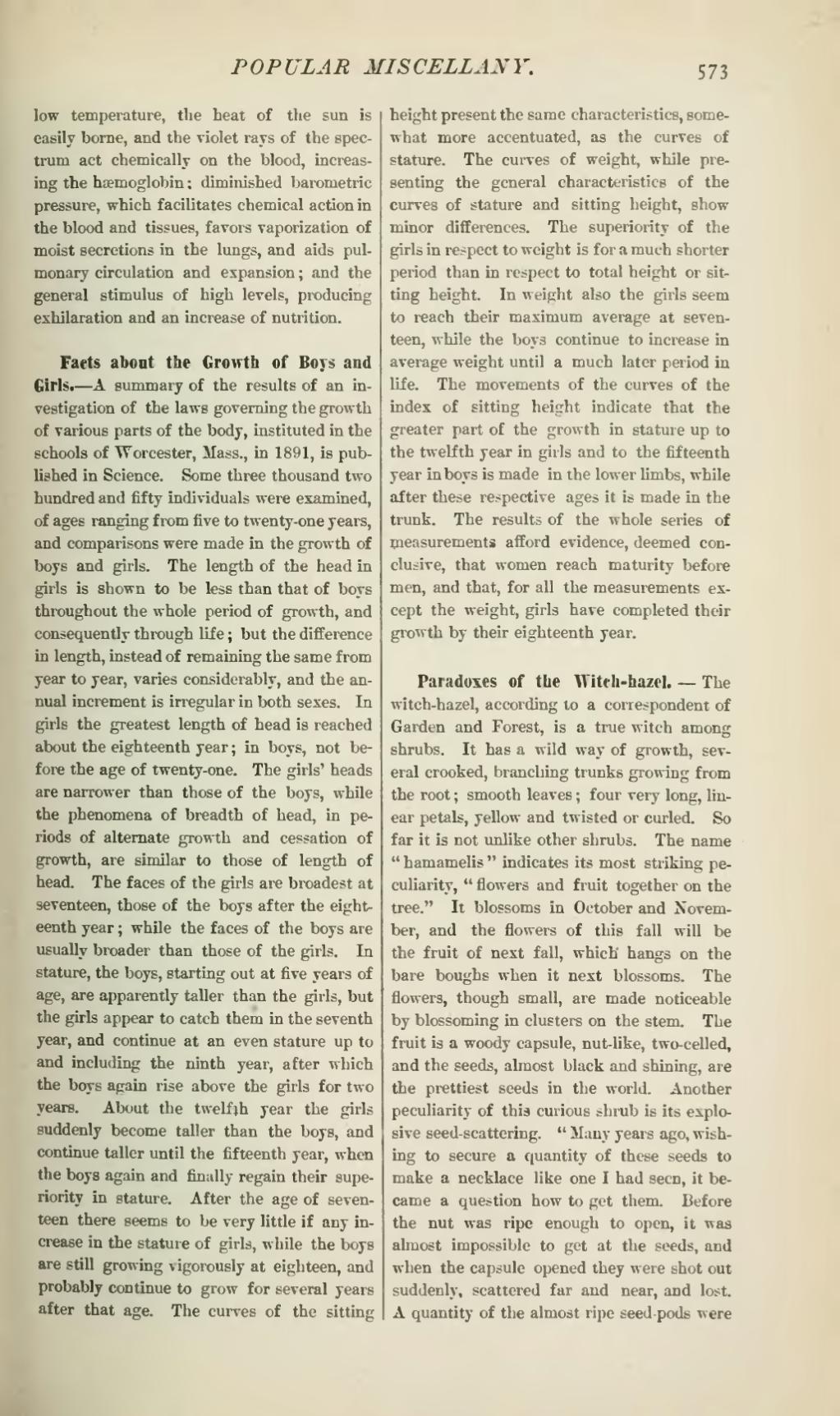low temperature, the heat of the sun is easily borne, and the violet rays of the spectrum act chemically on the blood, increasing the hæmoglobin; diminished barometric pressure, which facilitates chemical action in the blood and tissues, favors vaporization of moist secretions in the lungs, and aids pulmonary circulation and expansion; and the general stimulus of high levels, producing exhilaration and an increase of nutrition.
Facts about the Growth of Boys and Girls.—A summary of the results of an investigation of the laws governing the growth of various parts of the body, instituted in the schools of Worcester, Mass., in 1891, is pubUshed in Science. Some three thousand two hundred and fifty individuals were examined, of ages ranging from five to twenty-one years, and comparisons were made in the growth of boys and girls. The length of the head in girls is shown to be less than that of boys throughout the whole period of growth, and consequently through life; but the difference in length, instead of remaining the same from year to year, varies considerably, and the annual increment is irregular in both sexes. In girls the greatest length of head is reached about the eighteenth year; in boys, not before the age of twenty-one. The girls' heads are narrower than those of the boys, while the phenomena of breadth of head, in periods of alternate growth and cessation of growth, are similar to those of length of head. The faces of the girls are broadest at seventeen, those of the boys after the eighteenth year; while the faces of the boys are usually broader than those of the girls. In stature, the boys, starting out at five years of age, are apparently taller than the girls, but the girls appear to catch them in the seventh year, and continue at an even stature up to and including the ninth year, after which the boys again rise above the girls for two years. About the twelfth year the girls suddenly become taller than the boys, and continue taller until the fifteenth year, when the boys again and finally regain their superiority in stature. After the age of seventeen there seems to be very little if any increase in the stature of girls, while the boys are still growing vigorously at eighteen, and probably continue to grow for several years after that age. The curves of the sitting height present the same characteristics, somewhat more accentuated, as the curves of stature. The curves of weight, while presenting the general characteristics of the curves of stature and sitting height, show minor differences. The superiority of the girls in respect to weight is for a much shorter period than in respect to total height or sitting height. In weight also the girls seem to reach their maximum average at seventeen, while the boys continue to increase in average weight until a much later period in life. The movements of the curves of the index of sitting height indicate that the greater part of the growth in stature up to the twelfth year in girls and to the fifteenth year in boys is made in the lower limbs, while after these respective ages it is made in the trunk. The results of the whole series of measurements afford evidence, deemed conclusive, that women reach maturity before men, and that, for all the measurements except the weight, girls have completed their growth by their eighteenth year.
Paradoxes of the Witch-hazel.—The witch-hazel, according to a correspondent of Garden and Forest, is a true witch among shrubs. It has a wild way of growth, several crooked, branching trunks growing from the root; smooth leaves; four very long, linear petals, yellow and twisted or curled. So far it is not unlike other shrubs. The name "hamamelis" indicates its most striking peculiarity, "flowers and fruit together on the tree." It blossoms in October and November, and the flowers of this fall will be the fruit of next fall, which' hangs on the bare boughs when it next blossoms. The flowers, though small, are made noticeable by blossoming in clusters on the stem. The fruit is a woody capsule, nut-like, two-celled, and the seeds, almost black and shining, are the prettiest seeds in the world. Another peculiarity of this curious shrub is its explosive seed-scattering. "Many years ago, wishing to secure a quantity of these seeds to make a necklace like one I had seen, it became a question how to get them. Before the nut was ripe enough to open, it was almost impossible to get at the seeds, and when the capsule opened they were shot out suddenly, scattered far and near, and lost. A quantity of the almost ripe seed-pods were
